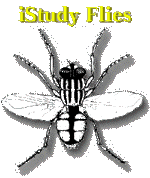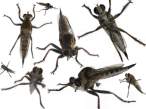
|
iStudy Flies - Flies in General: Introduction
FLIES IN GENERAL
In 2005, some 120,000 kinds of flies have been identified, while there are estimates of more than 1,000,000 species living today, according to research entomologist, Dr. F. Christian Thompson, of the USDA. [10] Our knowledge of insects has evidently grown so quickly that an earlier estimate by Harold Oldroyd -- Senior Principal Scientific Officer, British Museum (Natural History) London, and author of the only comprehensive account of flies in English, The Natural History of Flies (Norton, 1964) -- calculated that there were between 60,000 and 100,000 species of flies in an entry, "Fly," in the Encyclopedia Americana (2001). [11] Flies can be as large as the robber fly (7 centimeters or 2.76 inches long) and as small as a midge (1 millimeter). [12] With a body length of about 1/4 inch (0.64 cm), a thousand adult flies would weigh less than an ounce. The tongue (hypopharynx) of the fly is coated with a sticky glue; and, their body and padded feet bristle with hairs, to which clings dirt, dust, and bacteria that easily contaminate their landing surfaces. [13]
|
Member of Fohn.net

